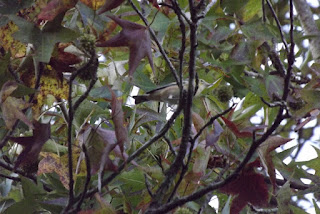Winter hasn’t arrived yet, technically, but most birders in
Mississippi tend to consider late November to be well into that season. The vast majority of Neotropical migratory birds
departed over a month ago, with winter residents taking their place. I birded quite a lot between early September
and early November, so I thought I would write a little about some of the
highlights of my fall 2020 birding experiences.
One of the most unusual migratory species that I found was an
Olive-sided Flycatcher. Some readers may
recall that I saw one of these last year, in a large snag in the
neighborhood. Olive-sided Flycatchers
aren’t exceptionally rare, but they’re scarce enough in Mississippi that
birders cannot expect to see one every year.
Therefore, seeing this species two years in a row strikes me as pretty
special. I spotted this year’s bird on a
fall migration count in Oktibbeha County, back in September. The bird was hunting insects from the top of
a dead tree, sallying almost straight upward—hallmarks of the Olive-sided
Flycatcher. The lighting wasn’t great,
but I managed to snap a few identifiable photos. The white patches behind the bird’s wings are
a good field mark to look for, but they may not always be visible.
 |
Olive-sided Flycatcher with overcast sky
|
The Olive-sided Flycatcher was exciting, but I generally
enjoy seeing the more routine migrants, as well.
I spotted many common warblers this
fall, including American Redstarts, Yellow-throated Warblers, Black-and-white
Warblers, Black-throated Green Warblers, and Northern Parulas.
Even though these are common birds, being
quick enough with a camera to snap pictures of them can be pretty difficult, so
I was able to photograph only two this fall: a Blue-winged Warbler in early
September, and a Bay-breasted in mid-October.
The Blue-winged Warbler was feeding in its typical leaf-probing style,
picking through the folds and crevices of leaf clusters to find small
insects.
The Bay-breasted Warbler, on
the other hand, foraged mostly by flitting from branch to branch and gleaning
insects from the surfaces of intact leaves.
 |
Blue-winged Warbler foraging in leaf cluster
|
 |
Bay-breasted Warbler -- sporting plumage of almost the same colors as the leaves!
|
On the same day that I photographed the Bay-breasted
Warbler, an interesting incident occurred at around 20 minutes before
sunset.
While I was watching the
Bay-breasted Warbler, I suddenly heard a medley of warbler
chip and
seet calls, and
then turned to see a small flock of warblers land in one of the large oaks in
the front yard.
This was definitely a mixed
flock, with at least one individual of each of the following species: Yellow-throated
Warbler, Magnolia Warbler, Black-throated Green Warbler, Bay-breasted Warbler, and
Yellow-rumped Warbler.
The Bay-breasted
was clearly a younger individual than the one I had photographed, since it had
less intense bay streaking on the flanks.
The flock hung around in the oaks and sweetgum trees for only a couple
of minutes before moving on.
Of course, not all of my noteworthy fall sightings were of migrants.
Although Barred Owls stay in Mississippi
throughout the year, autumn is often one of the best times to look for them, partly
because there are many first-year owls, which tend to be less wary than the adults. I can’t say for sure that the owls in the
following pictures were immatures, but they were certainly not skittish. The first picture was taken on a road in the Sam
D. Hamilton Noxubee National Wildlife Refuge during the fall migration count. My mom and I spotted the owl a short distance
down the road, and it was still on its perch when we drove back in the
opposite direction after finishing our tally in that area.
 |
Barred Owl
|
This second Barred Owl was seen in the late afternoon in
early November, perched along a road leading to Noxubee NWR.
This bird seemed just as fearless as the first
one, and wasn’t at all perturbed by my camera sticking out the window.
I haven’t seen it since, and I hope that it
has learned to avoid hunting in high-traffic areas.
 |
"Who?"
|
 |
One more picture for good measure: motion blur.
|
That was autumn.
As
winter approaches and the temperatures begin to drop, I’m starting to see far
more sparrows, Yellow-rumped Warblers, kinglets, and blackbirds foraging in the
woods and the backyard.
What will be the
highlights of this new birding season, I wonder?






